Updated: AOpen MiniPC – Imitation is the Sincerest Form of Flattery
by Jarred Walton on March 3, 2006 12:05 AM EST- Posted in
- Systems
System Benchmarks
We'll start with the most likely usage scenario, general office and system performance. PCMark 04 and 05 were run along with Winstones 2004. Note that both PCMark versions run some 2D and 3D tests, so the IGP will factor into those scores. The AOpen MZ855 could only complete PCMark04 due to the Intel Extreme 2 integrated graphics.
This is basically what we've come to expect from Pentium M systems. It comes out the slowest of all the tested systems, but even dual core Pentium D systems aren't much faster in business tasks. The fact is that the MiniPC does fine in office tasks - it's up to 35% slower than the A64 4000+, but you'll seldom notice. However, the MiniPC struggles a bit in multimedia tasks and is almost half as fast as the 4000+; in many multimedia tasks you will notice the difference. It's doubtful that anyone would really buy this box with the intention of doing lots of video editing, but it can still best most three-year-old PCs in just about every office-related task. The 2.5" 5400 RPM hard drive also has an impact on overall performance, but it's really not too bad compared to the old 4200 RPM drives from a couple years ago.
The Futuremark products show a bit larger spread, and 3DMark scores are almost superfluous for the test systems. Real games might be able to run on some of the IGP solutions out there, but the demanding titles will often struggle to get playable frame rates even at 640x480 with minimal detail settings. Half-Life (the original) did run quite well on all of the systems at 800x600 and even 1024x768 in some cases, but that's about as far as you'd want to go.
Notice also how much of an impact the 6600 GPU has on the Sempron system: we would rate the 3100+ as being slightly slower than the PM 740 overall, and definitely slower than any of the other tested CPUs in overall performance. However, the fastest systems that we tested with the best IGP solutions currently available are still completely dominated by one of the slowest shipping processors around, once you add in a moderate GPU. Does this mean that the MiniPC (or any of the other systems) aren't worth having? Of course not, provided that 3D/gaming isn't a requirement.
We'll start with the most likely usage scenario, general office and system performance. PCMark 04 and 05 were run along with Winstones 2004. Note that both PCMark versions run some 2D and 3D tests, so the IGP will factor into those scores. The AOpen MZ855 could only complete PCMark04 due to the Intel Extreme 2 integrated graphics.
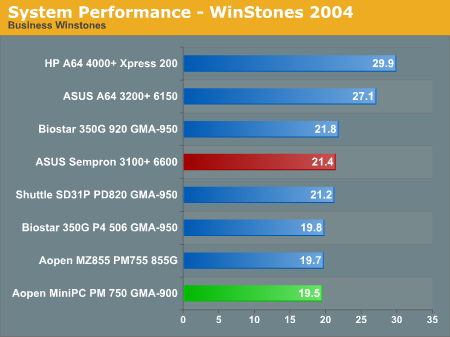
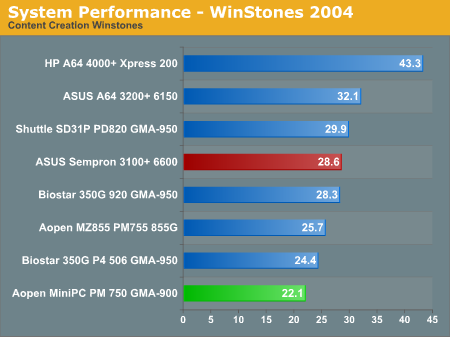
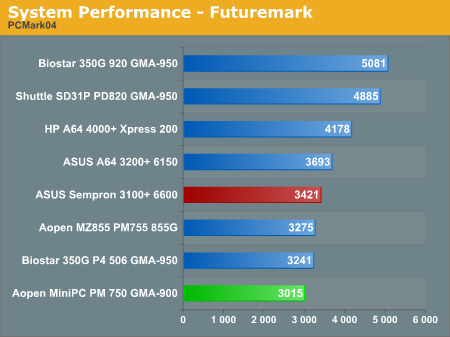
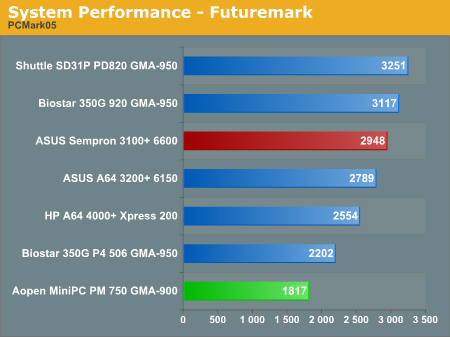
This is basically what we've come to expect from Pentium M systems. It comes out the slowest of all the tested systems, but even dual core Pentium D systems aren't much faster in business tasks. The fact is that the MiniPC does fine in office tasks - it's up to 35% slower than the A64 4000+, but you'll seldom notice. However, the MiniPC struggles a bit in multimedia tasks and is almost half as fast as the 4000+; in many multimedia tasks you will notice the difference. It's doubtful that anyone would really buy this box with the intention of doing lots of video editing, but it can still best most three-year-old PCs in just about every office-related task. The 2.5" 5400 RPM hard drive also has an impact on overall performance, but it's really not too bad compared to the old 4200 RPM drives from a couple years ago.
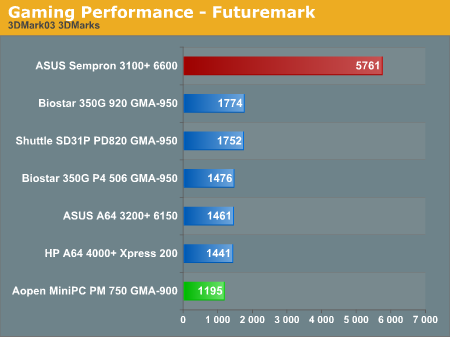
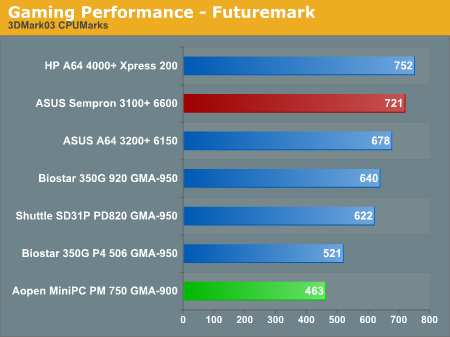
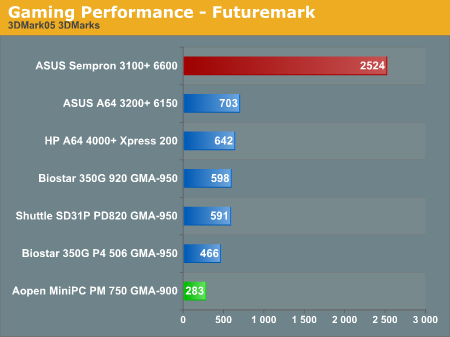

The Futuremark products show a bit larger spread, and 3DMark scores are almost superfluous for the test systems. Real games might be able to run on some of the IGP solutions out there, but the demanding titles will often struggle to get playable frame rates even at 640x480 with minimal detail settings. Half-Life (the original) did run quite well on all of the systems at 800x600 and even 1024x768 in some cases, but that's about as far as you'd want to go.
Notice also how much of an impact the 6600 GPU has on the Sempron system: we would rate the 3100+ as being slightly slower than the PM 740 overall, and definitely slower than any of the other tested CPUs in overall performance. However, the fastest systems that we tested with the best IGP solutions currently available are still completely dominated by one of the slowest shipping processors around, once you add in a moderate GPU. Does this mean that the MiniPC (or any of the other systems) aren't worth having? Of course not, provided that 3D/gaming isn't a requirement.










54 Comments
View All Comments
JarredWalton - Friday, March 3, 2006 - link
Okay, read that as "AOpen or one of their partners." The point is that AOpen can't possibly charge $330 for this unit (with DVDR) and expect people to prefer it over the new Mac Minis. $200 gets you a Pentium M, $100 for the HDD... and you're still missing the OS. Then again, $100 price premium over a Mac if you really want to run Windows isn't the end of the world. Would I recommend it over a Mac Mini? No. If you want to buy it, though, it's still a pretty cool system to play around with. I would definitely take it over the older G4 Mac Minis, because it's clearly faster in important areas (like HD stream decoding). If the MP945 launches at $850 or less for a complete Core Duo system, we have a worthwhile contender.JarredWalton - Friday, March 3, 2006 - link
Well, this is the initial version, and it does have a DVD+/-RW drive. The optical drive runs about $85 at retail, I think. I definitely agree that AOpen should be able to get the cost of the tested model down to the $650 range (including OS), which would put it up against he Core Solo Mac Mini that just came out.Furen - Friday, March 3, 2006 - link
The OS price is the killer...The T2300 (1.66GHz) costs around $240 bucks (yet the core solo costs like $210), plus the $330 for the motherboard and $100 for the OS and you're already at $670. Add HD, the ram and you're way over budget. I suppose going for a Celeron M is the solution to this problem considering that Celeron performance is pretty comparable with the Pentium M's.
JarredWalton - Friday, March 3, 2006 - link
That's why this needs to be sold as a pre-built system, including OS. Large businesses can negotiate very good deals with MS and Intel, and realistically there's no way the case/chassis/mobo/PSU costs $330. At wholesale component prices, they should be able to match the price of the Mac Mini. Sell more at a smaller profit margin is the idea, though again I'm not sure how many people would buy one of these. Guess we'll see what happens.